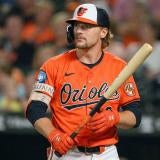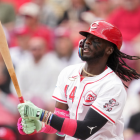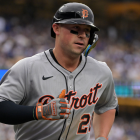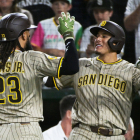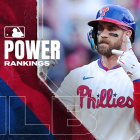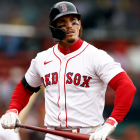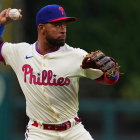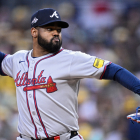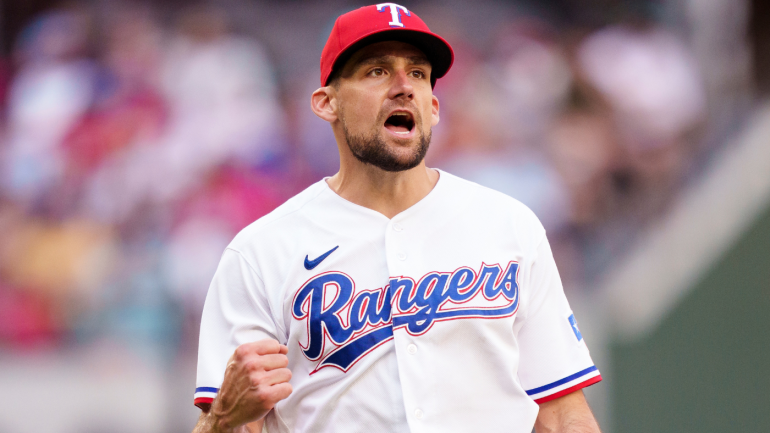
On Tuesday, the Texas Rangers announced that star right-hander Jacob deGrom will undergo Tommy John surgery next week. Recovery from the operation typically takes at least 12 months, with most teams these days erring on the side of caution and giving their pitchers closer to 14 months before they return to action. DeGrom, then, is certain to miss the remainder of this season and likely most of next.
That's an unfortunate development for the Rangers, who entered Wednesday with the second-best winning percentage (.667) and the best run differential (+155) in the majors. The Rangers can credit their excellent (and unexpected) first half in large part to the majors' best offense. If they maintain their current pace (6.4 runs per game), they would finish the season with more than 1,000 runs scored. Only three other teams in Major League Baseball history have ever scored that many runs in a season, and only one (Cleveland in 1999) has done it since integration.
But while a lot of attention has been used on the Rangers offense, their pitching staff has flown under the radar. To wit, they entered Wednesday ranked fourth in the majors in ERA. Just how have they performed so well to date, and can they keep it up the rest of the way without deGrom? Here are four things worth knowing about the Rangers' staff.
1. Eovaldi, Gray in midst of career years
The Rangers have spent a lot of money on veteran starting pitchers the last two offseasons. Not just with deGrom (and his five-year, $185M contract), but also Nathan Eovaldi, Jon Gray, Andrew Heaney, and Martín Pérez. Those investments are paying off this season, particularly in the cases of Eovaldi and Gray.
Eovaldi is shockingly one of the frontrunners for the American League Cy Young Award, having accumulated a 2.24 ERA (193 ERA+) and a 5.50 strikeout-to-walk ratio in his first 12 outings. He's one of five pitchers to clear 80 innings already, and he's done that while allowing what would be the weakest quality of contact of his career during the Statcast Era.
Gray, for his part, has a 2.51 ERA (172 ERA+) and a 2.55 strikeout-to-walk ratio in 11 starts. As with Eovaldi, this would be the weakest quality of contact Gray has surrendered in the majors.
Nathan Eovaldi, Messing with Timing, Individual pitches + Overlay
— Rob Friedman (@PitchingNinja) May 12, 2023
Turning 2 Splitters with the Same Velo into 2 different pitches. pic.twitter.com/ycXkAU8y9E
Sustainability is always going to be a question whenever a pitcher in their 30s achieves a new production threshold. There's some comfort to be found whenever an uptick in performance is accompanied by changes in their game -- then, it reasons, maybe the tweaks are the cause of the improved pitching and the gains are maintainable.
In both Eovaldi and Gray's cases, they've altered their pitch mix and their movement clusters in notable ways.
Eovaldi is throwing more cutters and splitters and fewer sliders and curveballs. Gray has reduced his fastball usage in favor of re-implementing his slider (to pair with his sweeper) and using his changeup at a would-be career high rate.
Each has seen their movement profile tweaked, too -- Gray, for example, has removed several inches of backspin from his changeup. It used to be that his fastball and changeup overlapped in movement. Now, they're closer to being two distinct pitches. It's worked for him to date.
Jon Gray's 2Ks in the 4th. 🐺 pic.twitter.com/zUgC14ra3W
— Rob Friedman (@PitchingNinja) June 3, 2023
Now, even with all that established, it's generally safer to bet on players regressing from career-best performance levels. (Hitters are allowed to adjust as well, limiting the long-term benefits of certain tweaks.) That doesn't mean Eovaldi and Gray will necessarily revert all the way back to their normal selves, and it doesn't mean that will happen this season -- career years have been a thing for as long as the game has existed.
Perhaps the most encouraging aspect of Eovaldi and Gray's years is the bigger picture. These tweaks suggest that someone in the organization -- be it top executive Chris Young, new pitching coach Mike Maddux, or whomever -- has a clear plan for how to get the most out of individuals pitchers, and that the pitchers -- both of whom have had fine careers -- trusted the vision enough to go along with it.
Even if Eovaldi and Gray do pitch worse heading forward, those are the kinds of developments associated with a healthy organization.
2. Dunning breaking out?
Another positive development on the Rangers staff entails the apparent ascent of right-hander Dane Dunning. Entering this season, he had a career 4.43 ERA (94 ERA+) in more than 300 big-league innings. Dunning has made 14 appearances so far this season, the most recent six being starts, and is sporting a 2.97 ERA as part of the rotation.
Alas, Dunning chose an inopportune time for his worst start of the season. On Tuesday night against the Cardinals, he surrendered four runs on three home runs and walked more batters than he struck out over the course of 5 2/3 innings. (The Rangers still secured the win.)
Dane Dunning, Wicked Back Foot Slider...Literally. 🤢
— Rob Friedman (@PitchingNinja) May 31, 2023
And Sword. ⚔️
Adding injury to insult... pic.twitter.com/jHw6Hebac7
Will Dunning keep up this level of performance the rest of the way? We're skeptical: his strikeout percentage has dropped from last season (so has his walk rate) all the way down to 15%, putting him in company with the likes of Noah Syndergaard, Brad Keller, and Marco Gonzales, among others. He's also giving up harder contact on average, and at a more optimized launch angle, this year than he did in 2022.
Dunning does generate more pop-ups and double-play balls than the average pitcher, so perhaps he'll continue to outpace his underlying metrics to an extent. At minimum, he's already given the Rangers more than they could've reasonably expected, and there's no taking those starts back -- no matter what happens from this point forward.
3. Statuses of Leiter and Rocker
Say the Rangers do need to replace another member of their rotation, be it because of injury or sudden underperformance -- do they have the internal means to do so?
Some of their top prospect arms have struggled so far this season. Cole Winn, for starters, has surrendered nearly an earned run and a walk for every inning pitched in 10 Triple-A appearances. Owen White has fared OK in Double-A, though his strikeout-to-walk ratio is on the ugly side of 2.0. Tekoah Roby, whose competitiveness has often been praised by scouts, has an ERA over 5.00 in his introduction to Double-A. In both White and Roby's cases, it's hard to say how much they've been impacted by the experimental pre-tacked baseball that's being used at the level.
What about the two minor-league pitchers in the Rangers system that most people know about? After all, the Rangers have used a lot of premium draft capital on pitching in recent years, selecting a pair of Vanderbilt right-handers with top three picks, in Jack Leiter (No. 2, 2021) and Kumar Rocker (No. 3, 2022). Could either factor in?
Mixing in his slider with his fastball,@Rangers No. 4 prospect Jack Leiter spins his 3rd quality start of the month for @RidersBaseball:
— MLB Pipeline (@MLBPipeline) June 1, 2023
6 IP
2 H
1 R
1 BB
4 K pic.twitter.com/K87yqu6cc2
Rocker, we can write with the utmost certainty, will not. He recently was sentenced to his own Tommy John surgery that will cost him the rest of 2023 and most of 2024. Prior to that, he had compiled a 3.86 ERA and a 6.00 strikeout-to-walk ratio over the course of six High-A starts.
It's harder to say with Leiter. In a repeat showing at Double-A, he's sporting a 3.88 ERA and a 2.16 strikeout-to-walk ratio in 11 starts. Those are improvements over the numbers he posted last season, and they've come while using the aforementioned new ball.
Leiter isn't far removed from walking seven of the 20 batters he faced in a start, suggesting that he remains an uneven quantity, albeit one who the Rangers could conceivably promote between now and season's end. Counting on him to be a difference maker, however, would be a mistake.
4. Trade market possibilities
Say the Rangers do, for whatever reason, decide to go outside the organization over the next month-plus to add a pitcher. Who might some of their options be? CBS Sports recently highlighted 20 potential trade candidates, including a number of hurlers.
While Shohei Ohtani would probably be off-limits for other American League West teams (if he's made available to anyone at all), the Rangers would have plenty of other veteran options to sort through. The White Sox could elect to move on from impending free agent Lucas Giolito, former Ranger Lance Lynn, and perhaps even Dylan Cease. The Guardians could move Shane Bieber, who has another season of team control remaining before he hits the open market. And the Giants could send Alex Cobb packing if they decide to sell ahead of the deadline.
Of course, there's still a lot of baseball to be played between now and then, making it certain that team circumstances will change in ways that shape the trade market. The Rangers found that out the hard way on Tuesday. Now, it's up to them to do whatever they can to secure their first division title since 2016 in the wake of deGrom's surgery.
![[object Object] Logo](https://sportshub.cbsistatic.com/i/2020/04/22/e9ceb731-8b3f-4c60-98fe-090ab66a2997/screen-shot-2020-04-22-at-11-04-56-am.png)








